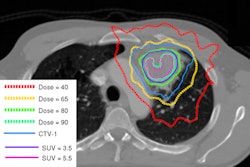Using real-time imaging and robotics to abandon fixed needle templates for prostate brachytherapy may be the best way to avoid penile bulb trauma during prostate cancer treatment, a researcher reported at the American Brachytherapy Society (ABS) annual meeting in April in San Diego.
J. Adam Cunha, PhD, a clinical instructor in the department of radiation oncology at the University of California, San Francisco, offered data that showed that the same doses of radiation can be delivered while moving away from the fixed needle attack on the prostate. The fixed needle attack technique often results in trauma to nearby organs and the penile bulb, which can lead to erectile dysfunction, among other complications.
"We are looking at trauma to other structures, including nerve bundles and vascularization," Cunha said. "We have a long tradition of using a template for needle insertion. At the same time, we have images that show what you want to avoid."
Because the current approach to prostate cancer brachytherapy is so effective, there's resistance to change. "The challenge of introducing a new technique is making sure we can deliver the dosimetry demonstrated to be highly effective," he said.
The robotics for the proposed procedures are being developed and tested at two locations, one at Worcester Polytechnic Institute and another at Johns Hopkins Medical Center.
The study shows that brachytherapy can deliver the same amount of radiation to the prostate gland using robotic technology tied to real-time ultrasound and fused MRI or CT images, according to Cunha. Trauma to nearby organs and structures, including the urethra, rectum, and bladder, can be avoided.
William Bice, PhD, chief of medical physics at John Muir Health Systems, was skeptical of the suggestion that needles in the bulb lead to erectile dysfunction. He stated that only two papers suggest that penile bulb trauma leads to erectile dysfunction.
"There's a paucity of papers that suggest that needles passing through the penile bulb cause erectile dysfunction," Bice said, noting that the two studies that most strongly suggest this originated in West Virginia. He suggested that when information originates in only one location, "that leaves room for doubt."
Cunha's study involved creating three needle configurations for each of 10 image sets of diseased prostates: template, conical, and freehand. All needle geometries involved entry at the perineum and terminated at the distal edge of the prostate. The conical and freehand configurations were specifically designed to avoid trauma to the penile bulb.
The set of possible seed positions was at least as dense as that obtained with a 0.5 x 0.5-cm rectangular grid template.
"Nontemplate needle patterns can be difficult to implant with current methods that do not take advantage of advances in imaging technology, but will become increasingly viable as robotic needle insertion devices begin to penetrate the market," Cunha said.



















